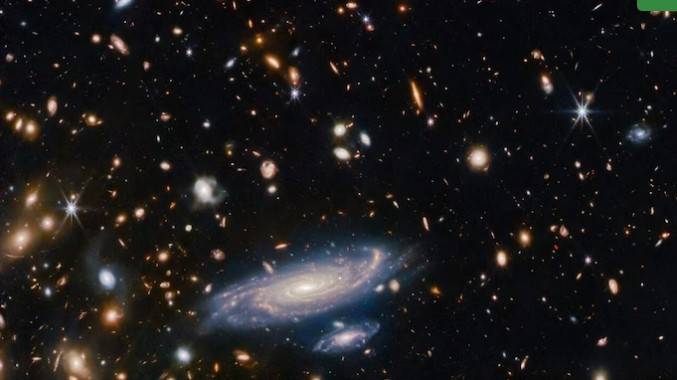James Webb telescope shows dancing galaxies

Stay tuned with 24 News HD Android App

The James Webb Space Telescope, working at the Lagrange Point 2 of the Sun-Earth system, has captured a crowded field of galaxies, reported 24NewsHD TV channel.
The image is covered with Webb’s signature six-pointed diffraction spikes with the large spiral galaxy at the base accompanied by a profusion of smaller, more distant galaxies.
Named LEDA 2046648, the large spiral galaxy is situated a little over a billion light-years from Earth, in the constellation Hercules. Researchers said that one of Webb’s principal science goals is to observe distant galaxies in the early universe to understand the details of their formation, evolution, and composition.
The image was captured during instrument calibration and helped test Webb's ability to dig up galactic "fossils." Nasa said that ancient galaxies are so far that as space expands, their light has stretched into infrared wavelengths, which is Webb's specialty.
Welcome to Galactic Park 🦕
— NASA Webb Telescope (@NASAWebb) January 31, 2023
Taken during instrument calibration, this image helped test Webb's ability to dig up galactic "fossils." Ancient galaxies are so far that as space expands, their light has stretched into infrared wavelengths — Webb's specialty. https://t.co/wrjKERkDWH pic.twitter.com/EpZ5y9PoqL
Bienvenidos al parque galáctico 🦕
— NASA en español (@NASA_es) January 31, 2023
Tomada al calibrar sus instrumentos, esta imagen demostró la capacidad de @NASAWebb para hallar “fósiles” galácticos. Las galaxias antiguas son tan lejanas que la expansión del espacio estira su luz hasta el infrarrojo: la especialidad de Webb. pic.twitter.com/GzzRybkf9s
The world's most powerful observatory is also equipped to probe the chemical composition of thousands of galaxies to shed light on how heavy elements were formed and built up as galaxies evolved."Webb’s keen infrared vision helps the telescope peer back in time, as the light from these distant galaxies is redshifted towards infrared wavelengths. Comparing these systems with galaxies in the local universe will help astronomers understand how galaxies grew to form the structure we see today," Nasa said in a statement. The image was captured using Webb’s Near-InfraRed Camera (NIRCam) as part of the commissioning campaign. NIRCam captured this galaxy-studded image while NIRISS was observing the white dwarf WD1657+343, a well-studied star.
The flying observatory had recently conducted an in-depth analysis of the deepest, coldest ice measured in the universe. Being called the most comprehensive census of the icy ingredients available to make future generations of stars and planets, the analysis identified carbonyl sulfide, ammonia, and methane, to the simplest complex organic molecule, methanol, in the ice.
